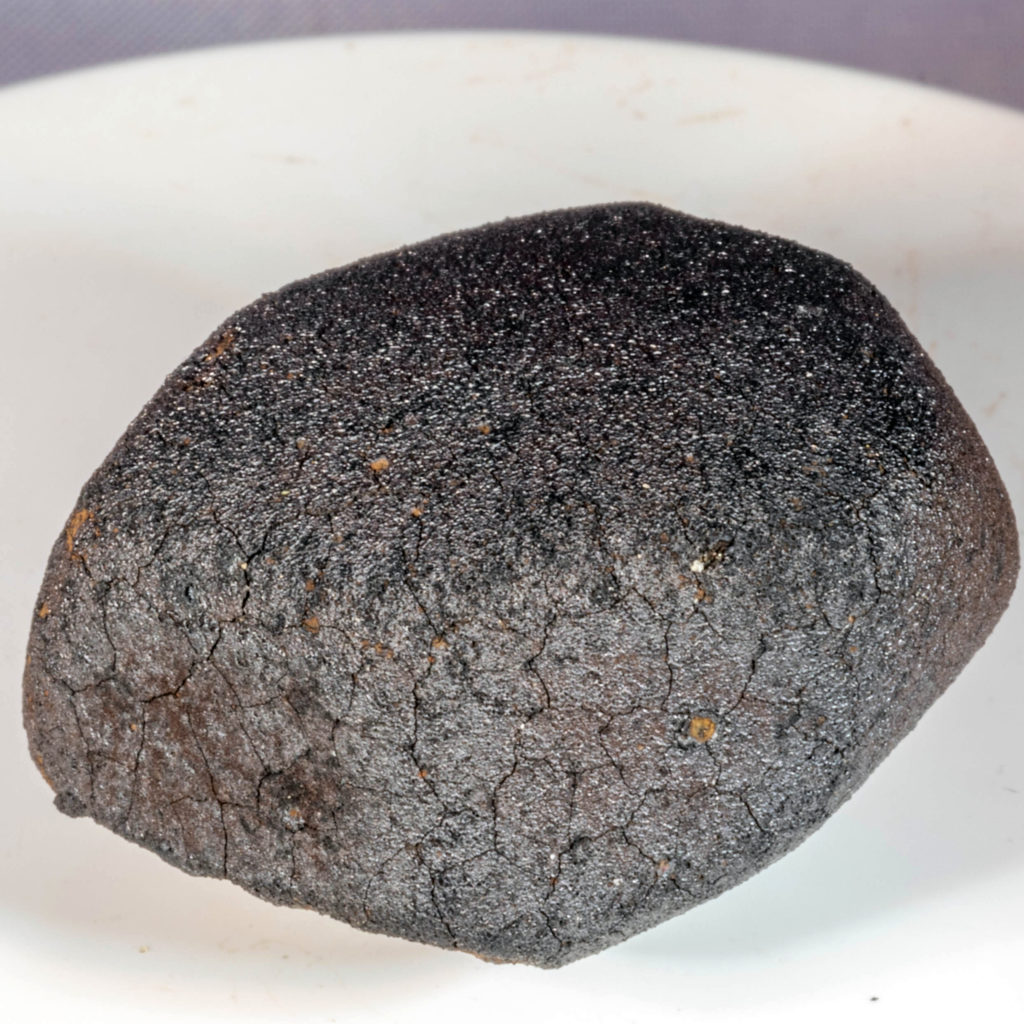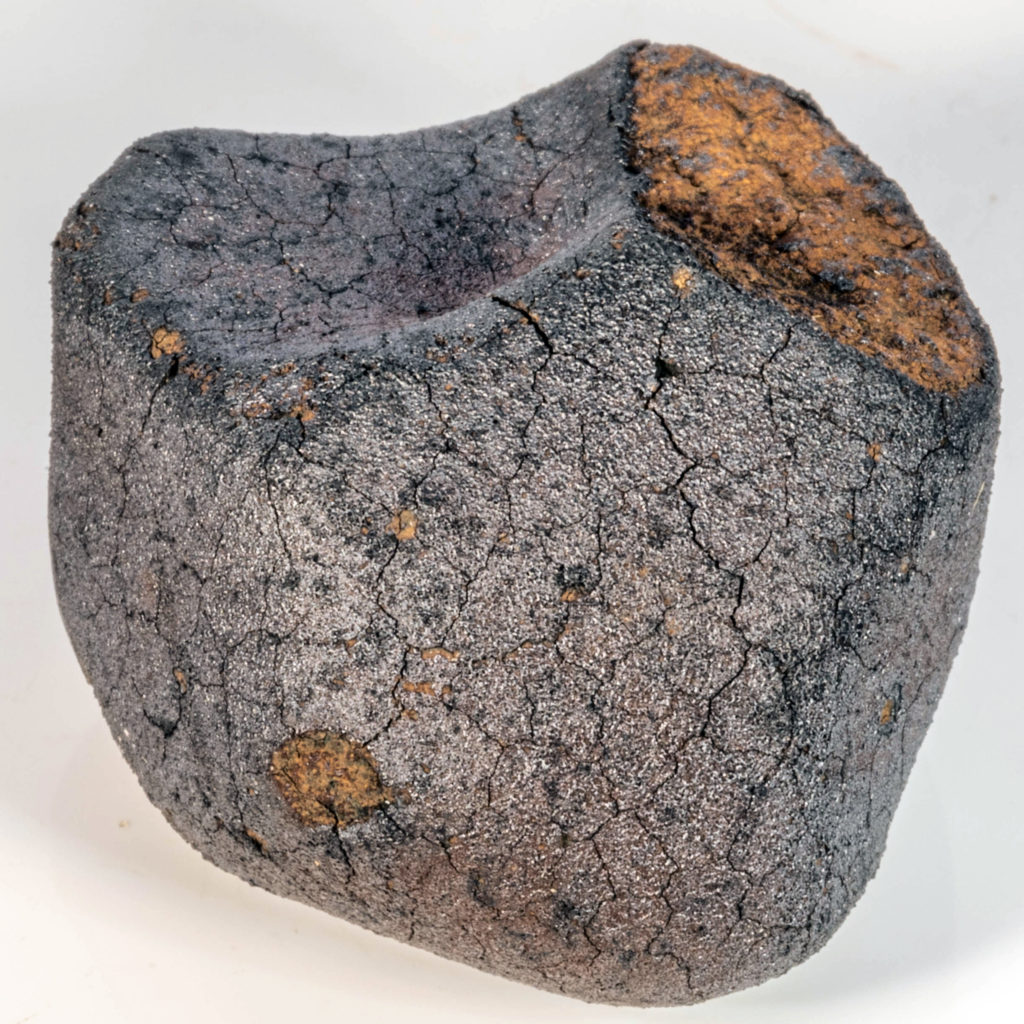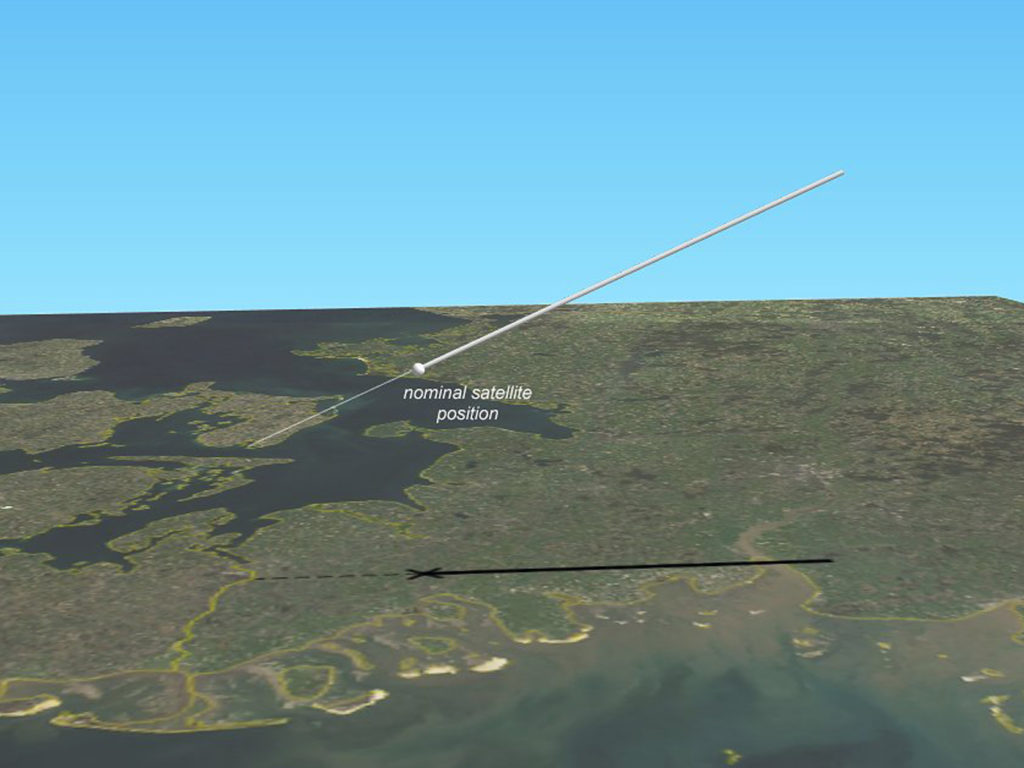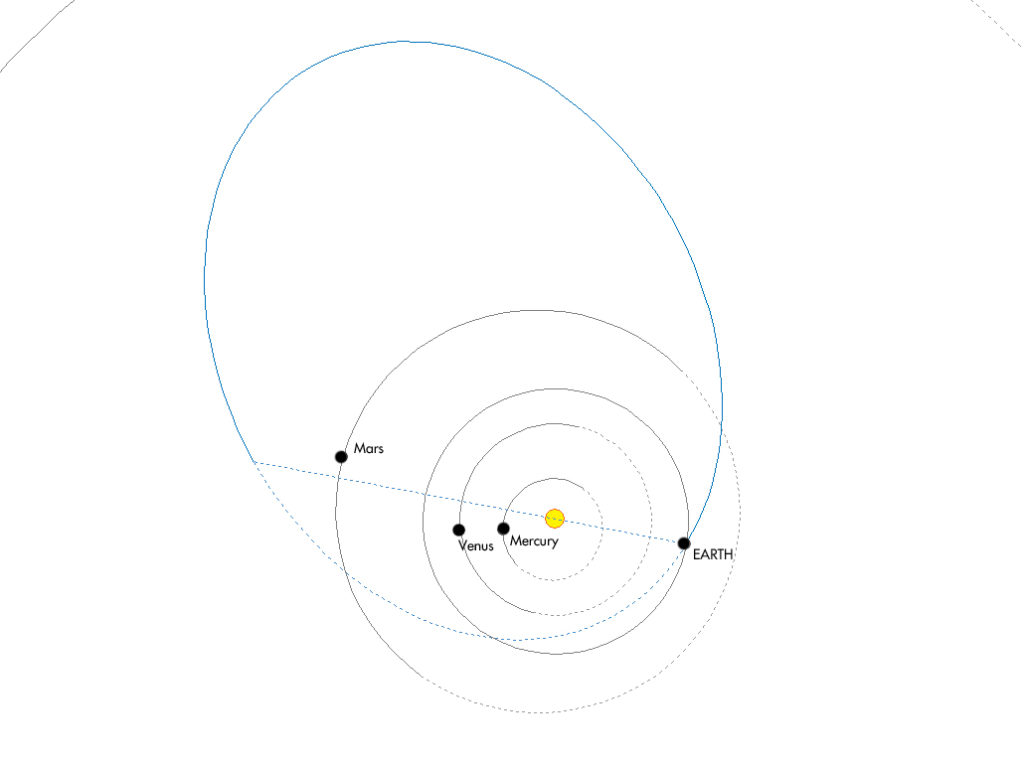FLENSBURG (C1-ung, 24.5 g, W0) meteorite fall in Flensburg, Schleswig-Holstein, Germany on 12 September 2019 at ~14:49:48 CEST (~ 12:49:48 UTC )
Last (minor) update: 12 May 2023

The intact meteorite on 27 September 2019. Photo: Carsten Jonas
On 15 September Erik Due-Hansen from Flensburg (Schleswig-Holstein, Germany) who reported his extraordinary find to the International Meteor Organization (IMO) website and sent four photos of the meteorite to Mike Hankey of the American Meteor Society (AMS) who then contacted the DLR and the German Arbeitskreis Meteore e.V. (AKM). While removing toys and other objects from the lawn before mowing it at around 11 a.m. on 13 September he found the table tennis ball-sized meteorite weighing 24.5 grams (~3.7 x ~3.5 cm, 1.984 g/cm³) by accident at location 54°45.6873’N, 9°22.7353’E (or 54°45’41.2″N 9°22’44.3″E ) in the centre of the garden of his house in the south-west of Flensburg on 13 September. Being interested in astronomy he immediately suspected that this unusually black and lightweight stone lying on top of his lawn was something special and must have fallen from the sky. He waited a few days, showed the meteorite to his father in Denmark and some friends, who also touched it, and then did some research on the internet and used a strong magnet on the meteorite. The meteorite had been exposed to some light rain and an elevated air humidity during the about 20 hours between its fall and the moment it was found.
“Ja, ich kam in den Garten um Rasen zu mähen und da lag es in der Mitten von meine Rasen, eine schwarze Stein, so eine drei Zentimeter große Stein, so mit kleine Risse drinne, verhältnismäßig leichte Stein und es lag ja oben auf’m Rasen und das war ja ‘n biss’n merkwürdig für einen Stein, dass es oben drauf auf die Rasen liegt und deswegen habe ich ja den Verdacht, dass es etwas vom Himmel gekommen war.” (Erik Due-Hansen)
[“I came into the garden to mow the lawn and there it lay in the middle of my lawn. A black stone, a three centimetre big stone with some small cracks in it, relatively light. And it lay on top of the lawn. And this was a bit unusual for a stone, to lie on top of the lawn. And because of that I suspected it had fallen from the sky.” (Erik Due-Hansen) ]
AKM members Carsten Jonas (53) and Laura Kranich (28) contacted and visited Due-Hansen on 27 September 2019. After interviewing him about the find and taking photos of the meteorite they convinced him to have the meteorite sent to Dieter Heinlein to be thoroughly analysed. AKM’s Mike Hankey, Andreas Möller, Felix Bettonvil, Laura Kranich and Carsten Jonas as well as Jim Goodall calculated the luminous trajectory and potential strewn field with slightly different results. From mid-September AKM’s Laura Kranich, Carsten Jonas, Sirko Molau, Jörg Strunk and other AKM members searched the vast calculated strewn field but could not find any other meteorites. At the IMC meeting in Bollmannsruhe on 6 October 2019 some information including a photo of the meteorite were made public during a presentation by AKM’s Sirko Molau. Dieter Heinlein meanwhile initiated the necessary scientific analyses which included measuring short-lived radio isotopes with Gamma spectrometry for two and a half weeks at VKTA’s Niederniveaumesslabor Felsenkeller in Dresden to determine the meteorite’s terrestrial age and thus establish a definite connection to the bolide event of September 12. The density of the meteorite was measured to be about 1.984 g/cm³. According to information provided by Dieter Heinlein the short-lived radio isotope analysis confirmed a very low terrestrial age and thus a connection to the bolide event above Schleswig-Holstein on 12 September 2019 (AMS event 4385-2019). A high resolution 3D-CT-scan of the meteorite has been done by Dr. Jose Ricardo da Assuncao Godinho at the Helmholtz Institute Freiberg for Resource Technology (HIF) to avoid further destructive analysis methods on the only find of this rare meteorite fall so far. According to the first results of a very difficult trajectory analysis by Dr. Jiří Borovička and Dr. Pavel Spurny of the Astronomical Institute of the Academy of Sciences of the Czech Republic the bolide had an atmospheric entry speed of almost 20 km/h at a slope of ~13 degrees to the horizontal. The luminous trail ended at a height of about 35 kilometres above the ground. Borovička suspects that “the fireball did not penetrated much deeper”. According to him “there may be a meteorite or several meteorites on the ground, but only small ones, several tens of grams at most for the largest one.” These analysis data make the actual meteorite find in Flensburg even more extraordinary. On 11 November 2019 the meteorite was sent to Prof. Dr. Addi Bischoff and doctoral student Markus Patzek for classification at the Institut für Planetologie at the University of Münster. The classification results were published on 5 February 2020 when the meteorite was officially registered as witnessed fall with the name FLENSBURG in the Meteoritical Bulletin database (MB 109). The meteorite’s main mass (17.03 grams) and classification specimen (6.54 grams) have been curated at the Institut für Planetologie (IfP) of the Westfälische Wilhelms-Universität in Münster (WWU) since 8 January 2020 after the main mass had been bought by the WWU. About 20 research institutes in Germany, France, Switzerland, the UK, the USA, Australia and Hungary have been working on the meteorite.
Radio isotopes have been measured with Accelerator Mass Spectrometry (AMS) by Dr. Silke Merchel at the HZDR (Institut für Ionenstrahlphysik und Materialforschung). So far a low concentration of four radio nuclides has been measured: 10Be and 26Al at the HZDR and 41Ca and 60Fe at the Australian National University (ANU). The results for 10Be and 26Al are reported to hint at an extremely low cosmic-ray exposure (CRE) age of the Flensburg meteorite, about 5000 years.
3D X-ray Computed Tomography scan of the Flensburg meteorite
(Dr. J. R. A. Godinho / Helmholtz-Zentrum Dresden-Rossendorf HZDR (Helmholtz-Institut Freiberg für Ressourcentechnologie, HIF), 28 April 2020)
The virtual three-dimensional model with a resolution of twelve micrometres (μm) shows density variations within the meteorite. Copyright: J. R. A. Godinho / HZDR
Trajectory and orbit of the unique carbonaceous meteorite Flensburg
Jiří Borovička, Felix Bettonvil, Gerd Baumgarten, Jörg Strunk, Mike Hankey, Pavel Spurný, Dieter Heinlein
Meteoritics & Planetary Science (MAPS), 2021
Update (9 February 2021): LINK
Addi Bischoff, Conel M. O’D Alexander, Jean-Alix Barrat, Christoph Burkhardt, Henner Busemann, Detlev Degering, Tommaso Di Rocco, Meike Fischer, Thomas Fockenberg, Dionysis I. Foustoukos Jérôme Gattacceca, Jose R. A. Godinho, Dennis Harries, Dieter Heinlein, Jan L. Hellmann, Norbert Hertkorn, Anja Holm, A.J. Timothy Jull, Imene Kerraouch, Ashley J. King, Thorsten Kleine, Dominik Koll, Johannes Lachner, Thomas Ludwig, Silke Merchel, Cornelia A. K. Mertens, Précillia Morino, Wladimir Neumann, Andreas Pack, Markus Patzek, Stefan Pavetich, Maximilian P. Reitze, Miriam Rüfenacht, Georg Rugel, Charlotte Schmidt, Philippe Schmitt-Kopplin, Maria Schönbächler, Mario Trieloff, Anton Wallner, Karl Wimmer, Elias Wölfer
Geochimica et Cosmochimica Acta, Volume 293, 15 January 2021, Pages 142-186, Available online 24 October 2020 – OPEN ACCESS
Mean Atomic Weight, Grain Density, and Porosity of Flensburg Unique Carbonaceous Condrite
Szurgot M. A.
84th Annual Meeting of The Meteoritical Society 2021 (abstract # 6006)
Hoffmann V. H., Wimmer K., Kaliwoda M., Schmahl W., Schmitt-Kopplin P.
52nd Lunar and Planetary Science Conference (2021), Abstract #2443
Occurrence of the Sodium Carbonate Shortite in the Flensburg C1 Chondrite
D. Harries
52nd Lunar and Planetary Science Conference (2021), Abstract #1953
Meteoritical Bulletin 109 entry:
“Petrography: (M. Patzek and A. Bischoff, IfP): Rounded to ellipsoidal relict chondrules (0.05 to ~1 mm in apparent diameter) and clusters of sulfide and magnetite grains are set in a dark, fine-grained matrix. The most abundant phases are different phyllosilicates and S-bearing phase(s) (probably tochinilite). The relict chondrules are free of any anhydrous silicates (such as olivine and pyroxene), contain abundant phyllosilicates and carbonates, and are often surrounded by sulfide laths. Troilite, pyrrhotite, and pentlandite were identified as sulfides. Carbonates occur as calcites, Mn-bearing dolomites, and a Na-rich phase. The mean apparent size of altered chondrules is ~150 µm.
Geochemistry: (M. Patzek and A. Bischoff, IfP): No olivine and pyroxene could be identified and analyzed. Defocused beam microprobe analyses (n = 135) revealed a bulk composition (in wt%) of: O: 32.0; Na: 0.29; Mg: 10.7; Al: 1.04; Si: 11.7; K: 0.04; P: 0.12; S: 2.04; Ca: 1.15; Fe: 16.0; Co: 0.03; Ti: 0.05; Cr: 0.25; Mn: 0.15; Ni: 0.85; Total: 76.3. O-isotopes (A. Pack; UGött): The oxygen isotope compositions of three analyzed fragments of Flensburg are: δ17O = 0.0806; -0.73023; -0.57844 ‰ and δ18O = 5.3032; 3.0272; 3.2993 ‰, Δ17O = -2.677; -2.304; -2.294 ‰ (relative to a reference line with a slope of 0.5305). The data are within the 16O-rich part of the field for CM chondrites.
Classification: Carbonaceous chondrite (C1-ung, W0). This meteorite is distinct from CM chondrites for the following reasons: chondrule apparent size (150 µm) is significantly different from that in CM chondrites (~270 µm), an heavily-altered CM would have a δ18O-rich composition compared to CM2 chondrites, Zn abundance (120 ppm) is too low for a CM (200 ppm without significant variations).
Specimens: Type specimen and PTS at IfP; the main mass is also at IfP.”
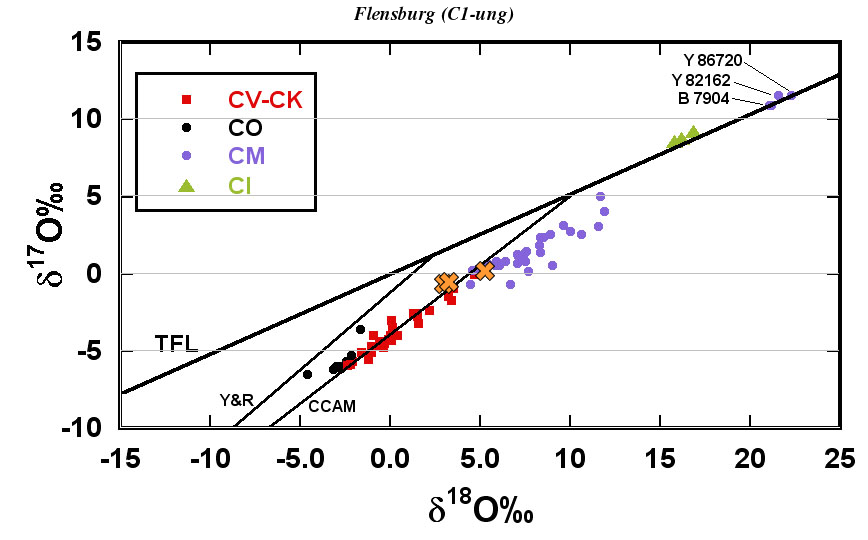
The meteorite
The meteorite shows a very fresh black and brown fusion crust with contraction cracks. Some patches of the lithology which lost their primary fusion crust are covered with an ochre-coloured thin layer of secondary fusion crust, which they probably acquired during the last stage of the atmospheric trajectory after fragmentation and a partial loss of primary fusion crust. Furthermore, there seem to be slight marks of a collision with another object or a hard surface.

The intact meteorite on 27 September 2019. Photo: Carsten Jonas
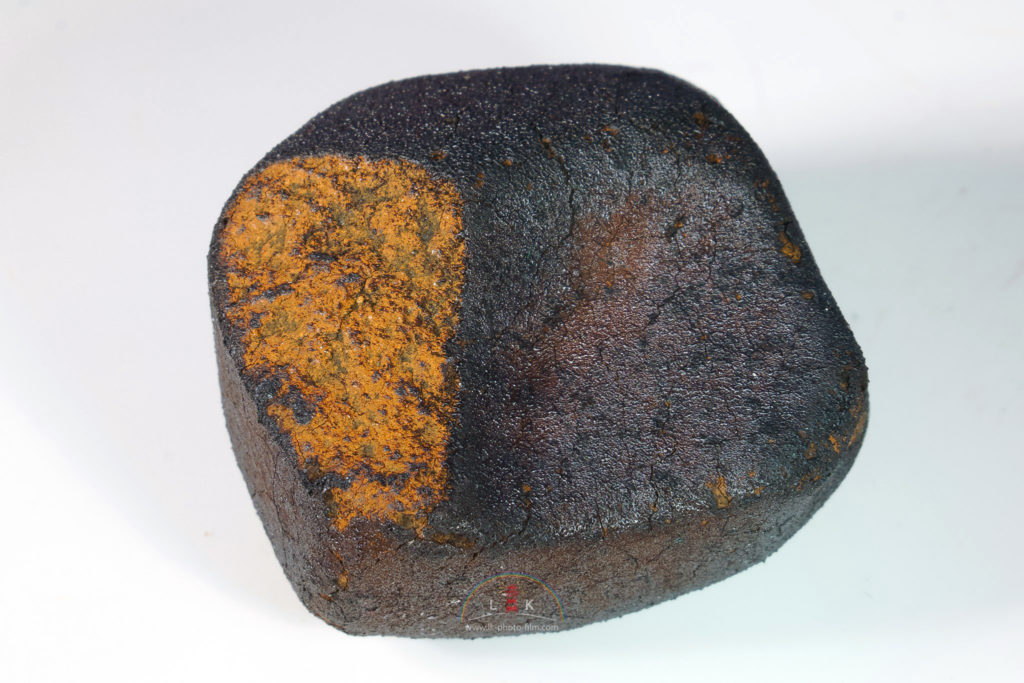
The intact meteorite on 27 September 2019, before classification. Photo: Laura Kranich (Photo & Film)
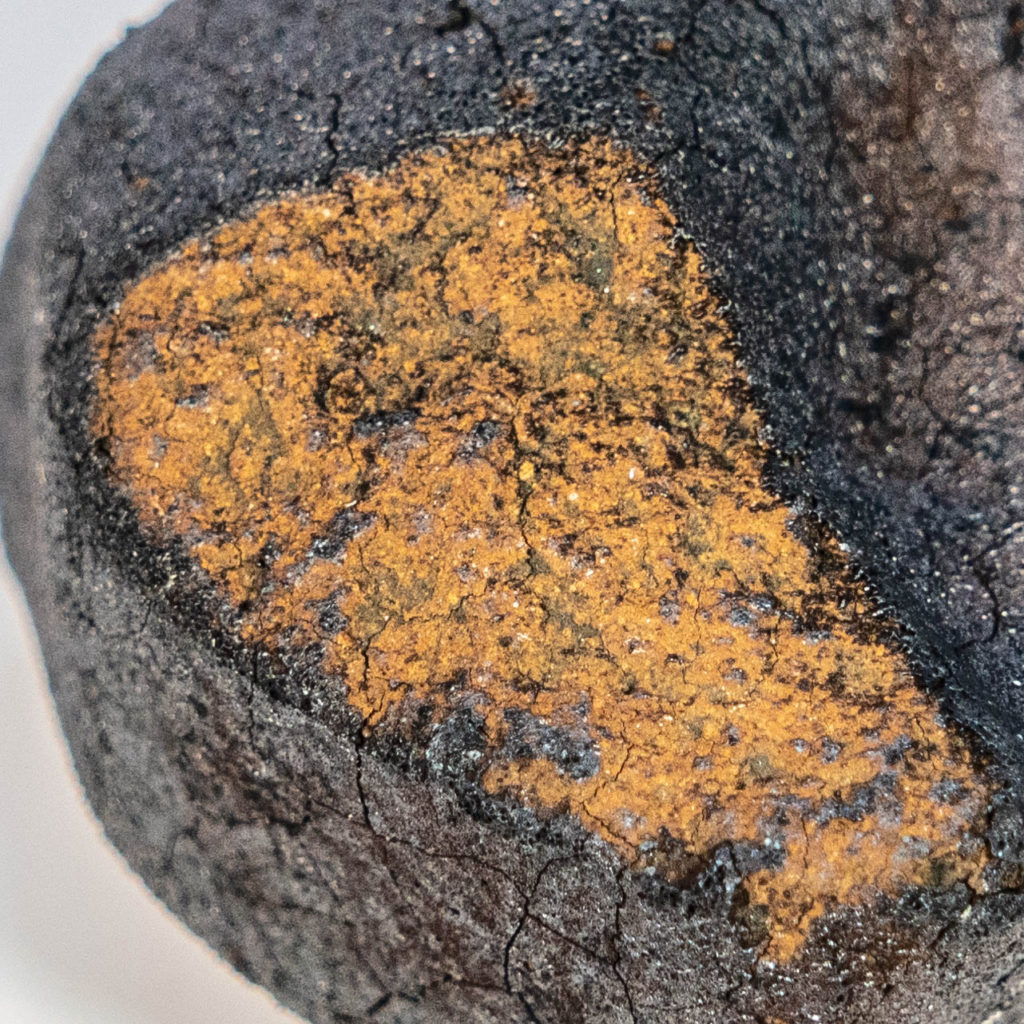
The unusual ochre-coloured secondary fusion crust on the exposed lithology of the meteorite. It is not representative of the actual lithology of the chondrite. Photo: Carsten Jonas
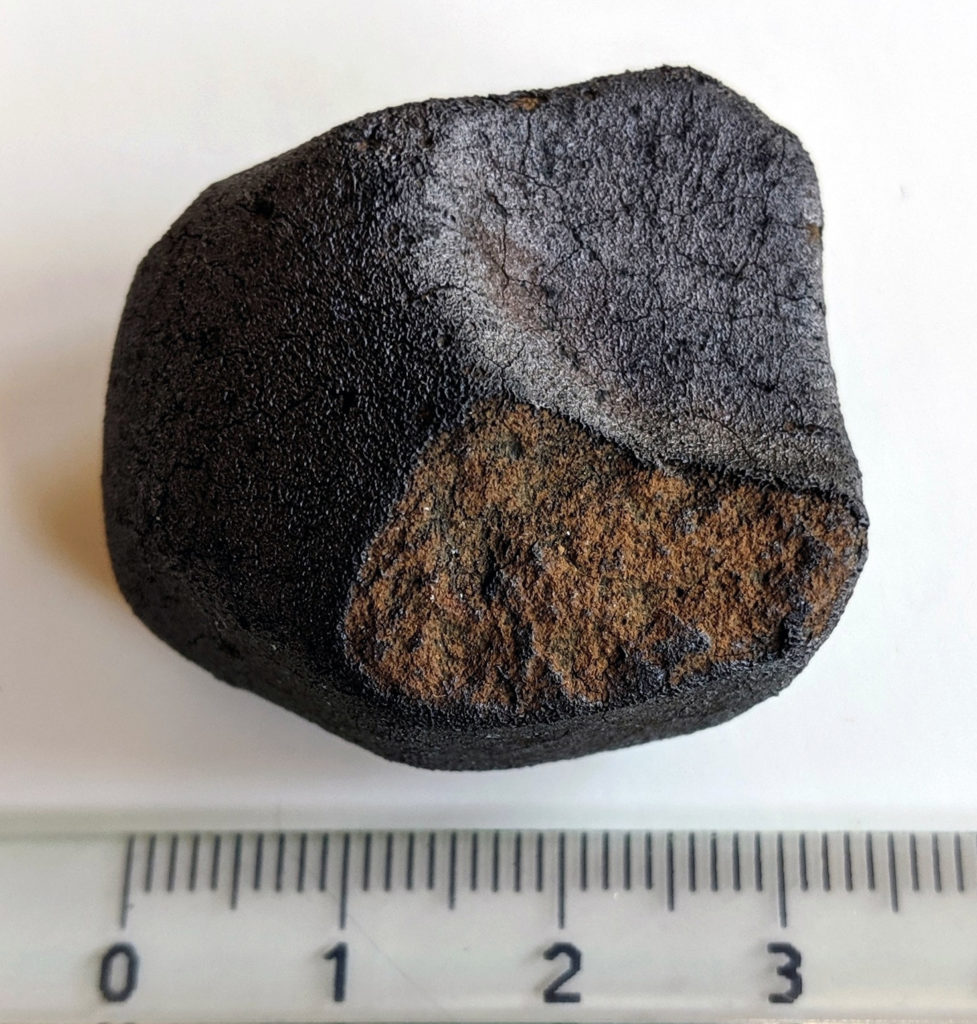
Photo: Erik Due-Hansen
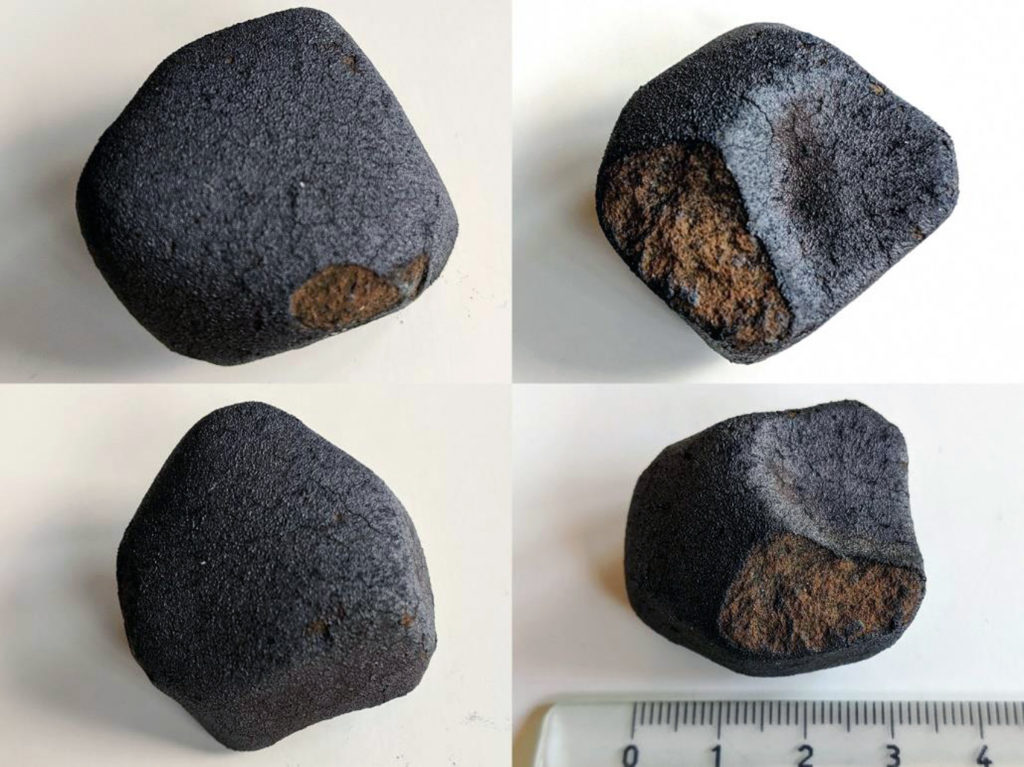
First photos of the meteorite. Photos: Erik Due-Hansen
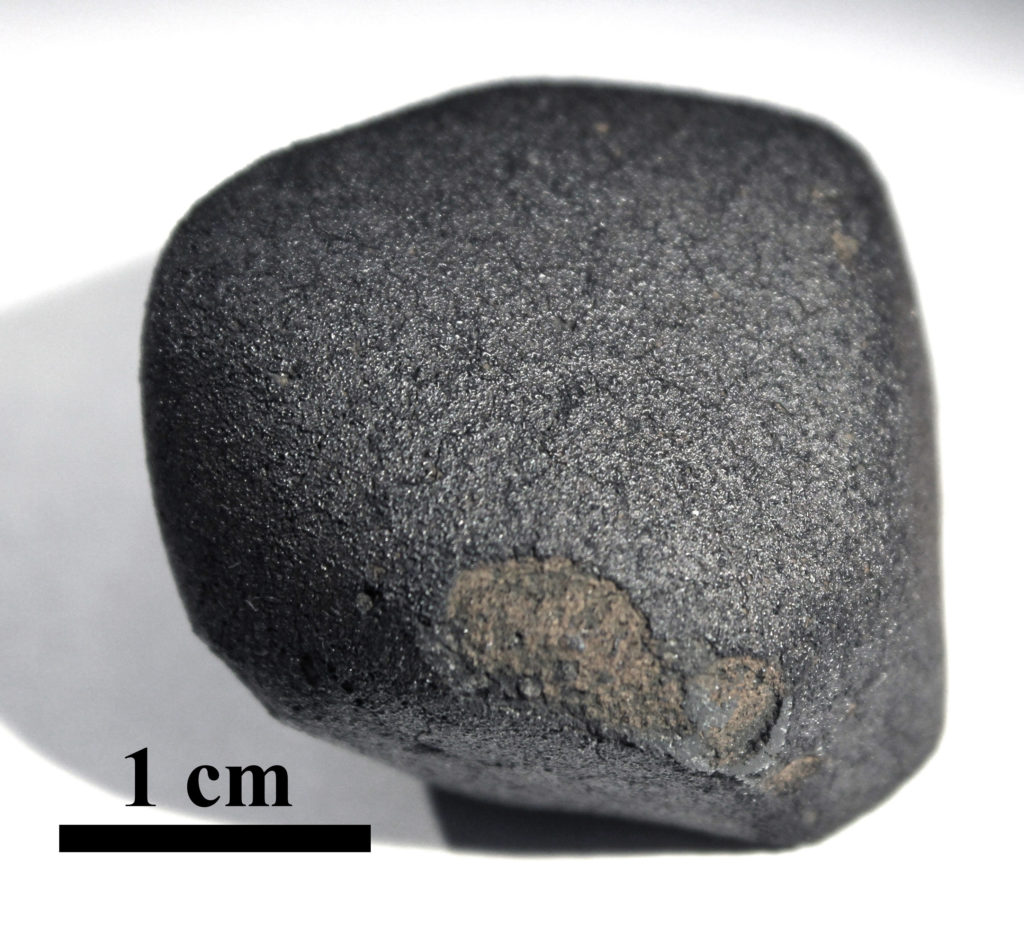
The intact Flensburg meteorite. Photo: Markus Patzek / Westfälische Wilhelms-Universität Münster (WWU)
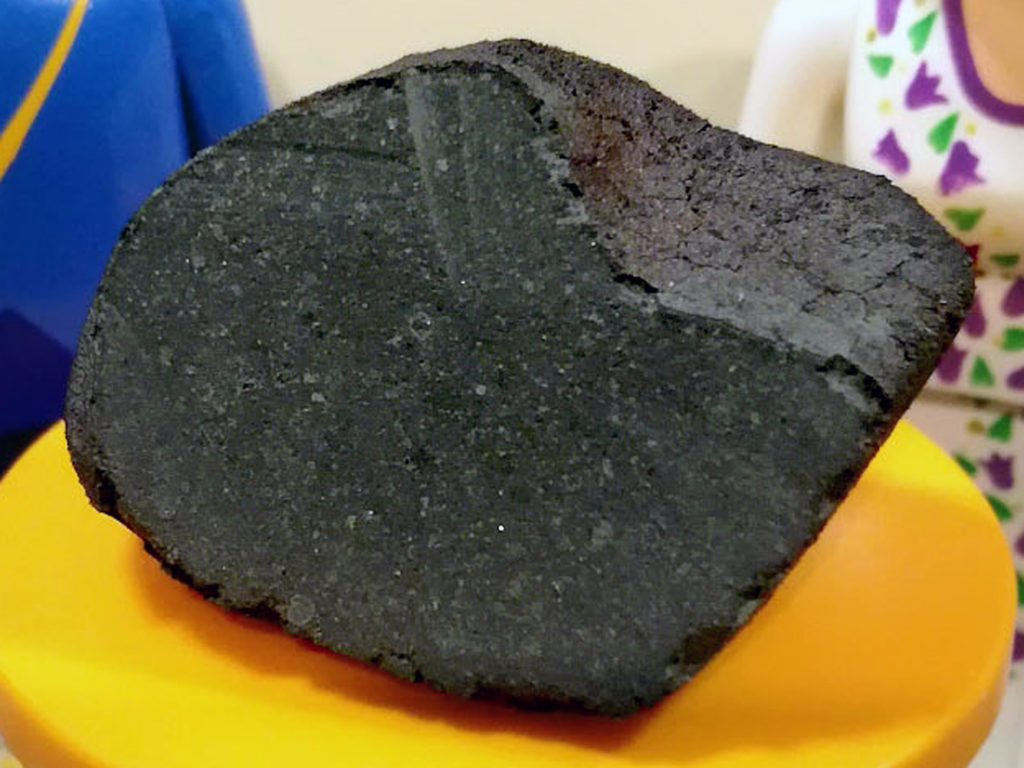
The lithology of the remaining mass after cutting off the classification type specimen. Photo: Dieter and Gabriele Heinlein

The remaining 17.03-gram main mass of the Flensburg meteorite after classification. Photo: ZDF
The bolide
The meteoroid with a pre-atmospheric diameter of 2 to 3 metres and a mass between 10,000 and 20,000 kg created a widely observed bolide. Its 90-kilometre luminous trail which lasted for 4.5 seconds started at a height of 71.84 ± 0.08 kilometres above location ~53.887 N, ~9.0322 E with an entry velocity of 19.43 ± 0.05 km/s (USGS: 18.5 km/s) then reached its maximum brightness at 12:49:48 UT at a height of 40.7 km (USGS: 42 km) and ended at a height of 35.3 ± 0.08 above location ~54.598 N, ~9.2060 E. The bolide’s atmospheric trajectory was calculated based on on-site stellar calibrated video recordings from Herford (Jörg Strunk), Nijmegen (Gerard Kemna), Rügen (Holger Scheele) and Almere (Leon Pepping) (see Borovička et al., MAPS 2021). It was seen by hundreds of eyewitnesses from the Netherlands, Germany, Belgium, Denmark and the UK. The AMS and IMO websites received more than 580 reports. Soon after the event some video recordings from the Netherlands and Germany appeared in social media. The Maritime Rescue Coordination Centre Bremen of the German Maritime Search and Rescue Service (DGzRS) received several reports from ships on the North Sea and initially considered the bolide to be an emergency signal between the islands Langeoog und Spiekeroog. They sent the two inshore lifeboats Neuharlingersiel and Secretarius into the area.

The bolide’s luminous trail (yellow) 53.887 N, 9.0322 E (71.84 ± 0.08 km) -> 54.598 N, 9.2060 E (35.3 ± 0.08 km), the find location of the meteorite (M), the calculated fall line (western red line) of meteorites (5-100 grams, increase south to north, with an assumed meteorite density of 2000 kg m-3 and ΓA=0.8) originating during the main fragmentation event (height 43-46 km) and the calculated fall line (eastern red line) of meteorites (5-50 grams, increase south to north, originating during the last major fragmentation event (height ~ 37 km). Up is north. (Data according to Jiří Borovička et al., MAPS 2021, see above)
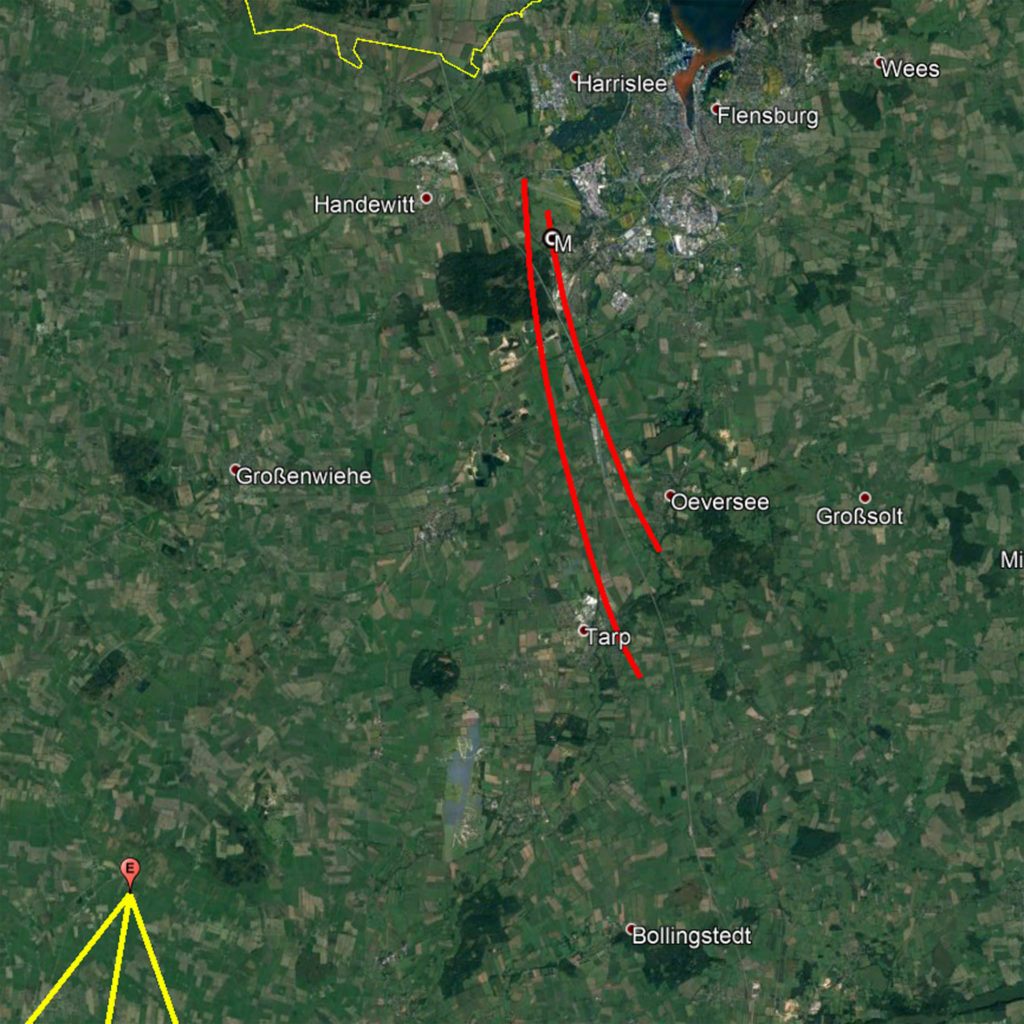
The find location of the meteorite (M), the calculated fall line (western red line) of meteorites (5-100 grams, increase south to north, with an assumed meteorite density of 2000 kg m-3 and ΓA=0.8) originating during the main fragmentation event (height 43-46 km) and the calculated fall line (eastern red line) of meteorites (5-50 grams, increase south to north, originating during the last major fragmentation event (height ~ 37 km). Up is north. (Data according to Jiří Borovička et al., MAPS 2021, see above)
Orbital Data (J2000.0)
| a (AU) | 2.82 ± 0.03 | ω (°) | 307.25 ± 0.16 |
| e | 0.701 ± 0.003 | Ω (°) | 349.207 ± 0.001 |
| q (AU) | 0.843 ± 0.001 | i (°) | 6.82 ± 0.06 |
| Q (AU) | 4.80 ± 0.06 | Period Y | 4.74 ± 0.08 |
Radiant Data (J2000.0)
| Observed | Geocentric | Heliocentric | |
| Right ascension (°) | — | 183.46 ± 0.11 | — |
| Declination (°) | — | -18.18 ± 0.14 | — |
| Ecliptical longitude (°) | — | — | — |
| Ecliptical latitude (°) | — | — | — |
| Initial velocity (km/s) | 19.43 ± 0.05 | 15.97 ± 0.06 | — |
Q = Aphelion, q = Perihelion, a = Semi-major axis, e = Eccentricity, i = Inclination, Ω = Ascending node longitude, ω = Argument of perihelion

Flensburg’s orbit (according to Jiří Borovička et al., MAPS 2021) compared to other known orbits of carbonaceous chondrites (Tagish Lake, Maribo, Sutter’s Mill) in projection onto ecliptical plane. Image: karmaka

Flensburg’s orbit (according to Jiří Borovička et al., MAPS 2021) compared to other known orbits of carbonaceous chondrites (Tagish Lake, Maribo, Sutter’s Mill). Image: karmaka
NASA-JPL’s CNEOS has released the following data of the bolide event:
Peak Brightness at 12:49:48 (UT) on 09-12-2019
Latitude (deg.): 54.5N
Longitude (deg.): 9.2E
Altitude: 42 km
Pre-impact velocity: 18,5 km/s
Vx -18,1
Vy:-0,4
Vz: 3,7
Total radiated energy (J): 16.9e10
Calculated total impact energy (kt): 0,48
Jim Goodall’s bulletin of the calculated strewn field (version 4) can be downloaded here: PDF / KMZ.
Video recordings of the daylight bolide
32-year old kiteboarder Dorian Cieloch from Bremerhaven recorded the bolide by accident from the mouth of the Weser river north of Bremerhaven, near Wremen, close to location 53°38’22.57″N, 8°29’30.81″E . This is about 106 kilometres (on the ground) south-southwest of the location of the bolide’s peak brightness as calculated by CNEOS. The bolide can be seen on the right of the frame above the hotel Deichgraf between 1:12 and 1:14 minutes of running time. Cieloch did not hear any detonation sound and did not notice the bolide while filming and editing the video. It wasn’t until the author of the first comment on his uploaded video made him aware of the ‘meteor’ in his recording that Cieloch became aware of the bolide he had captured by accident. Cieloch was interviewed in an NDR TV news report on the day after the fall.
“Hat sich trotzdem gelohnt herzukommen.” (D. Cieloch)
[Coming here has paid off nevertheless.]
The daytime bolide can be seen in the top right corner of the frame above the hotel Deichgraf (1:13 – 1:15 minutes). Video: Dorian Cieloch
Jonny Mählmann and three other members of the ‘Strandwache’ (lifeguard service) Wangerooge of the NGO Wasserwacht of the Landesverband Oldenburg E.V. of the German Red Cross (DRK) accidentally captured the bolide with a GoPro cam held by someone at the rear of their boat during a training trip off the shore of the island Wangerooge. This is estimated to be about 114 kilometres (on the ground) southwest of the location of the bolide’s peak brightness as calculated by CNEOS. The bolide can be seen in the top left corner of the frame between 0:21 and 0:24 minutes of running time. Video: Jonny Mählmann
Video by Holger Scheele from location 54°39’34.4″N, 13°19’56.4″E near Schwarbe, Rügen, Germany. This is about 269 kilometres (on the ground) east of the location of the bolide’s peak brightness as calculated by CNEOS. The bolide can be seen above the road in the centre of the frame between 0:02 and 0:04 minutes of running time. Video: Holger Scheele
Dashcam recording by Christian Hirsch, taken from location 52°18’52.1″N, 9°48’51.6″E , Hannover-Laatzen Expo Park. This is about 246.84 kilometres (on the ground) south of the location of the bolide’s peak brightness as calculated by CNEOS. The bolide can be seen above the trees and the 70-km speed limit traffic sign on the right side of the road between ~0:06 and ~0:08 minutes of running time. Video: Christian Hirsch
A security cam recording of shipyard Mertrade from location 52°42’24.9″N 5°52’07.2″E in Marknesse in the Netherlands. This is about 296 kilometres (on the ground) southwest of the location of the bolide’s peak brightness as calculated by CNEOS. Video: Omroep Flevoland
The bolide (close-up) in a video from a NV Westerscheldetunnel camera released by its employee Marchal van Lare, recorded from the N62 at location 51.456°, 3.743° near ‘s-Heerenhoek and Vlissingen-Oost, Netherlands. This is about 498 kilometres (on the ground) southwest of the location of the bolide’s peak brightness as calculated by CNEOS. Video: Marchal van Lare
A video by Jörg Strunk recorded with his AllSky6 (AMS21) from location 52.12364 N, 8.70178 E in Herford. This is about 266 kilometres (on the ground) south of the location of the bolide’s peak brightness as calculated by CNEOS. Video: Jörg Strunk
Other video recordings by Gerard Kemna (and Pascal van Lammeren) from location 51.84390 N, 5.82536 E in the Netherlands. Video: nu.nl
An early published dashcam video by Leon Pepping recorded from Bouwmeesterweg at location 52°24’00.6″N, 5°15’39.5″E in Almere Buiten in the Netherlands. This is about 350 kilometres (on the ground) southwest of the location of the bolide’s peak brightness as calculated by CNEOS. Video: Leon Pepping / Omroep Flevoland
Press releases and media coverage
Erste Untersuchungsergebnisse zum “Sensations-Meteoritenfall” von Flensburg (WWU press release, 17 February 2020)
Exotischer Besucher aus dem All (Press release, Helmholtz Zentrum Dresden Rossendorf, 29 April 2020)Television
Short television report (NANO, 3Sat, 17 February 2020, 6:49 p.m.) Interview with Prof. Dr. Addi Bischoff
Hallo Niedersachsen
NDR TV (13 September 2019, 7.30 p.m.)
In June 2020 Eric Due-Hansen was a guest in the quiz show ‘Kaum zu glauben’ (broadcast on NDR television on 19 July 2020) in which people had to guess what happened to him. He talked about the moment of his discovery and confirmed that for him supporting science was more important than having an object rot on his shelf at home.
(NDR TV, 19 July 2020)Meteorit im Garten: “Flensburg” ist ein bis jetzt einmaliger Sensationsfund (SHZ, 10 September 2020)
Reenactment of the story of the find in a German TV report
(Terra Xpress, ZDF, 3 January 2021, running time: 00:28-09:02 min.)
Radio
Flensburger Meteorit – Gespräch mit Astrophysiker Michael Büker
Deutschlandfunk Nova, Endlich Samstag, 22 February 2020, 10.40 a.m.
Interview with Carsten Jonas (Radio NDR 1 Welle Nord, 19 February 2020 5:50 p.m.)
Grüße aus dem All (‘Nachschlag’, podcast, 10 September 2020)
Press
Flensburger Tageblatt (30 November 2019)
Kieler Nachrichten (7 December 2019)

